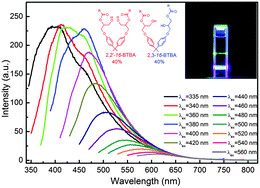Conformational dynamics and excitation wavelength dependent photoluminescence of decameric organic nanoparticles†
Abstract
We report a new type of fluorescent organic

* Corresponding authors
a
Department of Chemistry, National Changhua University of Education, Changhua 50058, Taiwan
E-mail:
cwchang@cc.ncue.edu.tw
Tel: +886-4-7232105 ext: 3555
b
Department of Chemistry, National Kaohsiung Normal University, No. 62, Shenjhong Road, Yanchao, Kaohsiung 82444, Taiwan
E-mail:
kmleetw@gmail.com
We report a new type of fluorescent organic

 Please wait while we load your content...
Something went wrong. Try again?
Please wait while we load your content...
Something went wrong. Try again?
H. Weng, K. Lee, Y. Chen and C. Chang, Phys. Chem. Chem. Phys., 2013, 15, 16935 DOI: 10.1039/C3CP52137K
To request permission to reproduce material from this article, please go to the Copyright Clearance Center request page.
If you are an author contributing to an RSC publication, you do not need to request permission provided correct acknowledgement is given.
If you are the author of this article, you do not need to request permission to reproduce figures and diagrams provided correct acknowledgement is given. If you want to reproduce the whole article in a third-party publication (excluding your thesis/dissertation for which permission is not required) please go to the Copyright Clearance Center request page.
Read more about how to correctly acknowledge RSC content.
 Fetching data from CrossRef.
Fetching data from CrossRef.
This may take some time to load.
Loading related content
